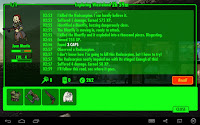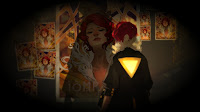Fallout Shelter is a
mobile/tablet game based on the Fallout series. I thought it looked
quite neat when it was revealed at E3 earlier this year, but because
I don’t own a smartphone or tablet, it wasn’t something I was
able to play. But now, thanks to the wonders of technology, it’s
possible to play Fallout Shelter on PC.
I’m actually playing it
right now, as I’m typing this. If there’s one good thing I can
say about Fallout Shelter, is that it’s a nice little game to have
running in the background when you’re busy with other things. Like
most mobile/tablet based games, it’s not really designed for
extended play, but short, productive bursts when you have anywhere
from 5 to 15 minutes to spare.
You play as an Overseer to
your own personal vault. You begin small, with a handful of rooms and
vault dwellers, but soon begin to expand. Rooms cost caps,
the currency of Shelter which can be earned in various ways – but
not, it should be noted, by an in-game purchase. Well, not quite.
We’ll get back to those later. Your vault and its residents require and consume
three resources – power, water and food – all of which are
generated by the appropriate rooms.
So let’s break down
exactly how this works – expanding your shelter and increasing your
population will generate more resources, but an increased population
also consumes
more resources. This creates a solid, if repetitive cycle of expand,
upgrade, populate and repeat. It’s undeniably addictive – at
least for a few days.
The primary limitation to
your expansion isn’t resources, however, but caps. Every room or
upgrade has a cap price. The prices are tolerable, but they can slow
expansion down to a tedious crawl during the early stages of the
game. Of course, it is possible to purchase more caps, but it’s not
as straightforward as you might expect. You can purchase ‘lunch
boxes’ which hold four or five random cards. These may be weapons,
outfits, dwellers, or a specific amount of a resource type or caps.
I’m not sure if this is
better or worse than simply selling caps in variously sized bundles.
At least then you’re guaranteed to get the caps you want, but using
this system, there’s no way of knowing exactly what you’re going
to get. It feels a little insidious, the system encouraging people to
buy ‘just one more box’ in the hope of getting what they need.
No, I’ve not bought any
boxes myself, but I can’t deny the temptation is there. We’re not
all immune to slick presentation. Every time you open a mystery box,
it’s like a little pleasure button being pushed in your brain. And
the game teases you with these boxes, tossing you a few free ones
early on to whet your appetite.
And Fallout Shelter is very
slick. It looks great, has nice sound effects and animations. Its UI
could use some work though, especially when you want to examine
dweller statistics at a glance, or sort through your inventory. And
yes, it’s fun to play. It’s neat watching your shelter expand,
assigning dwellers to various roles based upon their stats. Training
them, levelling them up, sending them out to the wasteland to
scavenge for supplies and hopefully return alive.
The game seems relatively
bug free, but I’ve had issues with the random raider attacks – my
assigned guards either ignoring the raiders, or running off to
another part of the shelter. I also had an odd issue where I quit the
game for a few hours, leaving my vault in good shape, only to return
and find it in a terrible state with nearly zero resources and all of
my dwellers suffering from radiation exposure. I still don’t know
quite what happened but it forced me to restart.
My main problem with
Fallout Shelter is that it’s all just too simple and repetitive.
Like I said, it’s undeniably addictive for a few days, but the more
you play, the more you realise just how shallow, limited and
ultimately pointless the experience is. There’s no depth, challenge
or complexity. I was disappointed by the dweller management, hoping
to do more than simply equip them with an outfit and assign them to a
room.
What about shift
management? What about assigning supervisors to different
departments? What about letting us f**k with the dwellers in weird
and wacky experiments? And there’s very little in the way of random
or exciting events aside from the same outbreaks of fires, roaches or
little bands of raiders. There’s really not much to it at all, when
you stop to think about it.
‘Exploring’ the
wasteland is just a slow way of gathering random gear…to make it
easier to gather more
random gear. You expand your shelter to generate more resources…in
order to expand your shelter to generate more
resources. During the early stages of the game, increasing your stash
of caps takes time, but you’ll eventually reach the point when
you’ll be able to generate more than you really need.
This means that although
the game opens up in terms of expanding and upgrading your vault,
there’s also nothing really left for you to do but sit back, watch,
and gather resources you no longer require. There’s no ‘end game’
as such, because Shelter only gets easier the longer you play.
There’s no real goal, other than to expand until you’re tired of
it. It’s just a mater of – expand, upgrade, expand, upgrade, get
bored, start over, rinse and repeat.
Which isn’t actually such
a bad thing. The structure, though repetitive, works.
The problem is, there’s simply not enough variation to make it
interesting. There’s not enough different types of rooms, dwellers
or styles of vault you can build. Ultimately, every vault will
operate the same, and once you figure out the most efficient method
of expansion, there’s very little reason to deviate from it.
It doesn’t help that you
can’t pick and choose what rooms to build regardless of the cost,
as every room is ‘locked’ out until you hit a certain population.
This means that your vault layout will typically always follow the
same structure. It severely limits player creativity in terms of
vault design. What’s even worse, is that if you decide to remove a
room because you don’t like its placement, you only get back a tiny
fraction of its cost, discouraging experimentation.
The ability to force your
dwellers to have children offers some amusement, as you play a
somewhat twisted game of eugenics as you attempt to selectively breed
the best ‘stats’ in their offspring (although it doesn’t seem
to make much of a difference). There’s something a little insulting
about it though, as it basically reduces your female dwellers to baby
factories. Not to mention, when pregnant, your women are utterly
useless in a crisis – seriously, they just run about and wave their
arms in the air.
Fallout Shelter isn’t a
bad little game, but it’s far too shallow and simplistic to
seriously hold my attention. I was hoping for more complexity and
depth to the vault and dweller management. But ultimately, it only
offers a simple and repetitive experience, one which begins to lose
its appeal after only a few short days when you realise you’ve seen
everything it has to offer. It’s a shame, because managing a
Fallout vault is a pretty cool idea for a game, but Fallout Shelter
sadly falls short of its potential.





























